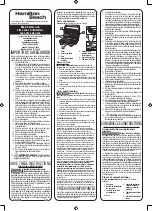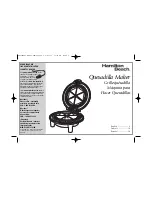
3
Care and Cleaning
Before initial use and after each subsequent use, wash the skillet and cover in hot, soapy water.
Do not use steel wool or abrasive kitchen
cleaners.
Rinse and dry thoroughly.
NOTICE:
Repeated washings in an automatic dishwasher will cause the nonstick properties of the ceramic coating to slowly diminish.
In addition, the bottom of the pan will likely discolor due to the caustic nature of the dishwasher detergent, and a gray residue may form
on the skillet bottom and may transfer onto towels and/or skin.
Do not immerse Control Master
heat control in water or let it come in contact with any liquid.
In time, the nonstick finish may darken over the heating element. To minimize or remove this discoloration, sprinkle baking soda over
the discolored area. Add enough water to make a paste. Allow paste to sit for several minutes and then scour with a plastic scouring pad,
such as Scotch-Brite* Dobie* Cleaning Pad, or a damp cloth. Wash and dry thoroughly. Repeat the procedure, if necessary.
Periodically check the screws on the cover handle and skillet legs for looseness. Retighten, if necessary.
NOTICE:
Continuing to tighten,
once secure, can result in stripping of screws or cracking of handles and legs.
IMPORTANT:
To ensure continued accuracy of the Control Master
heat control, avoid rough handling in use and storage.
Glass Cover Care and Use Instructions
CAUTION!
Your glass cover may break for no apparent reason if you fail to follow these instructions. Broken glass can cause personal
injury or property damage.
Do not use cover if it is chipped or cracked. Handle cover carefully and avoid rough handling.
Do not handle hot cover with wet towel or place hot cover on a cold or wet surface. Sudden, extreme changes in temperature may cause
glass to break. Allow cover to cool before washing.
This cover is dishwasher safe. Keep the cover clean. Do not use steel wool cleaning pads or abrasive powders which can scratch or weaken
the glass. Nonabrasive pads or powders may be used if necessary. Do not scrape or gouge glass with hard or sharp utensils.
Temperature –Timetable
Approximate
Approximate
Food
Temperature
Cooking Time
Food
Temperature
Cooking Time
Frying
Bacon
300°–325°
8–10 minutes
Canadian Bacon
275°–300°
3–4 minutes
Chicken
325°–350°
25–40 minutes
Eggs
Fried
250°–275°
3–5 minutes
Scrambled
250°–275°
3–5 minutes
Fish
325°–375°
5–10 minutes
French Toast
300°–325°
4–6 minutes
Ham
½˝ thick
325°–350°
10–12 minutes
¾˝ thick
325°–350°
14–16 minutes
Hamburgers, ½˝ thick
325°–375°
8–12 minutes
Minute Steak
375°–400°
4–5 minutes
Pork Chops
½˝ thick
325°–375°
15–20 minutes
¾˝ thick
325°–375°
20–25 minutes
Potatoes, Cottage Fried
300°–350°
10–12 minutes
Sausage
Link
300°–325°
20–30 minutes
Precooked
325°–350°
10–12 minutes
Sandwiches, Grilled
300°–325°
5–10 minutes
Steak, Beef, 1˝ thick
Rare
350°–400°
6–7 minutes
Medium
350°–400°
10–12 minutes
Steak, Beef, 1½˝ thick
Rare
350°–400°
8–10 minutes
Medium
350°–400°
18–20 minutes
Baking
Pancakes
350°–400°
2–3 minutes
Simmering
†
In an electric skillet, foods will heat to simmering at some point between the WARM setting and 200°. Heat the skillet at 350° until the food boils; then
place cover on pan and reduce the heat to simmer level by turning the heat control down until the pilot light goes out.
Braising or Pot Roasting
This cooking method involves browning food, usually meat or vegetables, in oil, butter, etc. and then simmering in a small amount of liquid over low
heat. To brown meat and/or vegetables, use a temperature between 325° and 350°. After browning, simmer as instructed above.
Holding Temperature
(after cooking period)
WARM
* Scotch-Brite and Dobie are trademarks of 3M Company. Presto is not affiliated with 3M Company.
† Add additional liquid during cooking, if necessary, to obtain desired consistency.






















